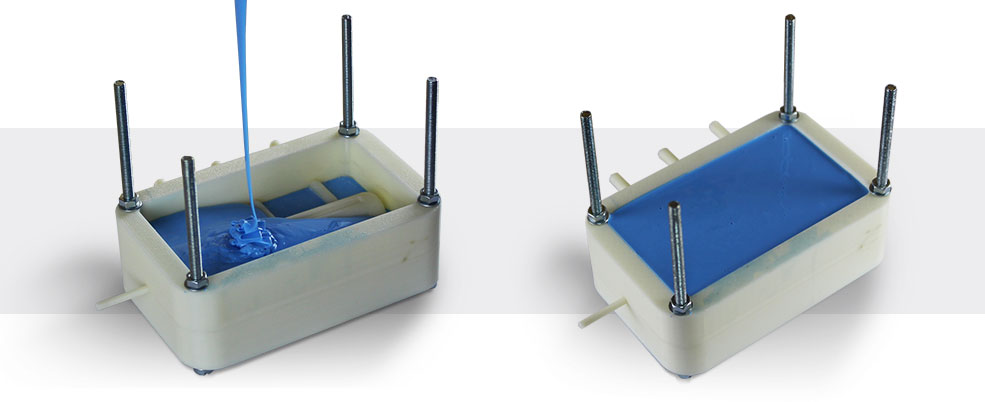Efficient Industrial Molding with 3D Printing. [Tutorial]
If molding process is necessary for your production, but you are in fact a bit pushed off after realizing how much time and effort and money it will take, you don’t have to give up your plans. Instead, you may want to check out the newest techniques like 3D printing which is one of the most available methods of individual production.
A 3D printer is not only a tool for manufacturing goods, its potential also gives you the ability to implement new ideas at the spot and learn from your mistakes. That’s basically the thing which can help your workshop and ideas really develop.
In this blog post, we would like to show you an overview and key benefits of using 3D printing in the process of industrial molding. The full step by step process of preparing a master pattern for molding can be found in our free tutorial 3D Printing in Modern Mold Making.
 Screwdriver handle mold
Screwdriver handle mold
Small Input = Great Results
The sufficient equipment necessary for preparing molds consists of a Zortrax 3D printer and a set of silicone and resin molding compounds. No special supply base is necessary, only a 3D printer which is the core element responsible for bringing efficiency and innovation to the well-known method of creating molds.
Probably most of you are aware of the fact that the technique known as RTV molding isn’t in fact anything new or unknown, but still with a little upgrade we can squeeze out more from it and be impressed with the results. Information concerning time, cost and efficiency parameters compared to traditional molding can be found below.
• Replacing machined pattern with a 3D printed one makes the time of mold-making process shrink by 40%.
• High printing speed allows fast iteration – get instant results of your work and show it to your stakeholders, even at the earliest stage of your work.
• With 3D printing each variation could be created in 1-2 hours and alterations are made on the spot. One can easily change the pattern in Z-Suite and recreate/remaster the previous design.
• Accuracy of printing guarantees the proper quality of the castings and complexity of details which gives the molds properties close to end-use parts. It allows creating complex master patterns which would be difficult or impossible to create by other means.
• Preparation of the master pattern is quicker and much cheaper compared to traditional methods – time is reduced from 50% up to 80% while costs are lowered to 40%-75%.
• The transition from the design stage to the test stage takes 1 day only and each stage of product design takes days instead of weeks thanks to the use of 3D print.
• Having a 3D printer makes the whole process less complicated as you don’t have to outsource creating the master pattern or other elements.
Process Overview
The main factor to speed up the process of molding was based on incorporating a 3D printer as a tool for preparing the parts necessary for casting, mainly the master pattern and the mold box. These elements are then used to create multiple casts of an end-use part. The whole process starts from designing the elements in any CAD program, converting the 2D model into a 3D one by exporting the file to Z-Suite and printing the patterns. The optional choice at this stage is to use various post-processing methods to smooth out the finished products. All the manuals covering the post-processing techniques for 3D prints can be found in our Support Center.
The mold form is made by pouring the silicone into the mold box and waiting for it to cure. After the pattern is finished, you can use it to make casts for the resin carefully injected to the pattern with inserted stem. Completely dried and after the cure time, the product is finished and the pattern could be used multiple of times.
 Preparing for molding
Preparing for molding
Safety Comes First
The vital thing to stress is the safety of the whole process. Room temperature vulcanization doesn’t require high temperatures, so there is no real danger of being burned by the liquid compounds. The substances used to create molds and the pattern are non-hazardous and produce minimal odor and fumes as the moderate molding temperature doesn’t cause intense vaporizing.
 Preparing the mold
Preparing the mold  Finished screwdriver handle
Finished screwdriver handle
A Powerful Combo
The process itself proves that by applying the new approach we can improve the efficiency of molding. Combining these two techniques is mainly responsible for labor reducing and broadening the variety of created casts as 3D printing doesn’t impose many limits on complexity of produced models.
The core benefits will influence the user experience directly as testing, implementing and evaluating the results is within one’s reach almost instantly. Producing highly adaptable elements can strongly affect the reception of an end-use product and result in satisfactions on both sides when the changing requirements are finally met. Get the complete tutorial covering all the details concerning utilising 3D printing in soft plastic molding for free.